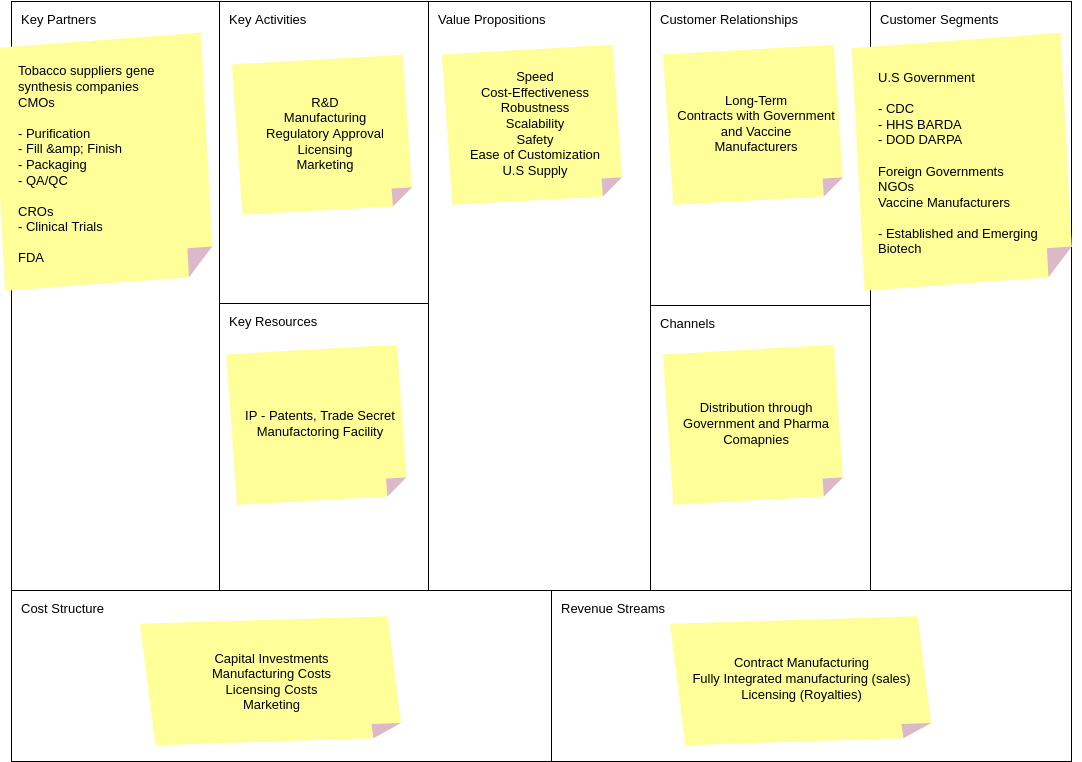Complete Guide to the Business Model Canvas (BMC)
Introduction to the Business Model Canvas (BMC)
The Business Model Canvas (BMC) is a strategic tool that visually outlines the key components of a business model. Developed by Alexander Osterwalder, it provides a clear and concise framework for entrepreneurs and organizations to map out how they create, deliver, and capture value.
Key Features of the BMC:
- Visual Framework: The BMC consists of nine interconnected building blocks, making it easy to see how different aspects of a business relate to one another.
- Collaborative Tool: It encourages teamwork and brainstorming, allowing diverse perspectives to shape the business model.
- Flexible and Adaptable: The canvas can be easily modified, enabling businesses to pivot and adjust their strategies as market conditions change.
The Nine Building Blocks:
- Customer Segments: Identifies the different groups of people or organizations your business serves.
- Value Propositions: Describes the unique value your products or services provide to customers.
- Channels: Outlines how you deliver your value proposition to customers.
- Customer Relationships: Defines the type of relationship you establish with each customer segment.
- Key Activities: Lists the most important actions your business must take to succeed.
- Key Resources: Identifies the essential assets required to deliver your value proposition.
- Key Partnerships: Highlights external organizations that help your business operate effectively.
- Cost Structure: Analyzes the major costs involved in your business model.
- Revenue Streams: Details how your business generates income.
Below is a detailed guide using the provided example, which appears to focus on a biotechnology company involved in gene synthesis and research and development (R&D).

The Nine Components of the BMC
1. Key Partners
Definition: The external organizations or entities that help your business model function effectively.
Example:
- Tobacco suppliers for gene synthesis components.
- CMOs (Contract Manufacturing Organizations) for production capabilities.
- Regulatory bodies (e.g., FDA) for compliance and approvals.
- Clinical trial partners to facilitate testing and validation.
2. Key Activities
Definition: The most important actions your company must take to operate successfully.
Example:
- R&D: Conducting research to innovate and improve products.
- Manufacturing: Developing and producing gene synthesis products.
- Regulatory Approval: Navigating the approval process for new products and technologies.
- Marketing: Promoting products to target markets and stakeholders.
3. Key Resources
Definition: The essential assets required to deliver your value proposition.
Example:
- Intellectual Property (IP): Patents and trade secrets that provide a competitive edge.
- Human Resources: Skilled scientists and engineers with expertise in biotechnology.
- Trade Secrets: Proprietary processes or formulations that enhance product offerings.
4. Value Propositions
Definition: The unique value your business offers to customers.
Example:
- Cost-Effectiveness: Providing competitive pricing for gene synthesis solutions.
- Robustness: Offering reliable and high-quality products.
- Customization: Tailoring solutions to meet specific customer needs.
5. Customer Relationships
Definition: The types of relationships you establish with your customer segments.
Example:
- Long-Term Contracts: Engaging in ongoing partnerships with government organizations and agencies.
- Collaborations: Working closely with clients for joint projects and research.
6. Customer Segments
Definition: The distinct groups of people or organizations you aim to serve.
Example:
-
U.S. Government Agencies:
- CDC (Centers for Disease Control and Prevention)
- HHS BARDA (Biomedical Advanced Research and Development Authority)
- DOD DARPA (Defense Advanced Research Projects Agency)
- Established and Emerging Biotech Companies: Firms looking for gene synthesis solutions.
7. Channels
Definition: The methods through which you deliver your value proposition to customers.
Example:
- Distribution through Government and Pharma Partners: Leveraging existing relationships to reach end-users effectively.
8. Cost Structure
Definition: The major costs incurred by your business model.
Example:
- Capital Investments: Costs associated with setting up labs and manufacturing facilities.
- Manufacturing Costs: Expenses related to producing gene synthesis products.
- Marketing Costs: Funds allocated for promoting the business and its offerings.
9. Revenue Streams
Definition: The sources of income for your business.
Example:
- Contract Manufacturing: Revenue generated from producing products for other companies.
- Licensing (Royalties): Income from licensing intellectual property to other organizations.
How to Use This Guide
- Gather a Team: Include individuals from various departments to provide diverse perspectives.
- Brainstorm: Use the examples provided to stimulate discussions around each component.
- Fill in the Canvas: Create a visual representation using sticky notes or a digital tool to capture ideas.
- Refine Your Model: Review and iterate on each component, ensuring alignment with your strategic goals.
- Test and Validate: Seek feedback from stakeholders and potential customers to validate assumptions.
- Implement and Monitor: Use the finalized BMC to guide business development efforts and regularly revisit it for adjustments.
Conclusion
The BMC is an invaluable tool for startups, established businesses, and anyone looking to innovate their business model. By providing a structured yet flexible approach, it helps organizations clearly define their strategy and align their efforts towards achieving their goals. By following this guide and utilizing the example provided, businesses can develop a comprehensive understanding of how to create, deliver, and capture value in their respective industries. This structured approach fosters collaboration, encourages strategic thinking, and enhances the overall effectiveness of business development initiatives.

